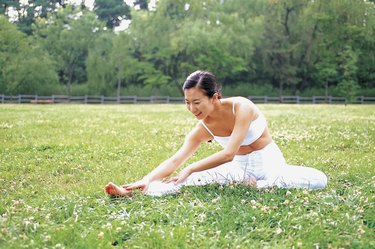
Flexibility refers to the range of motion in a muscle or joint that can help you improve movement and athletic performance. Different types of stretching exercises produce various results in how you move and perform. Some types relax your mind and body while others prepare you for movement. The National Academy of Sports Medicine recommends that you do flexibility training before and after your workout.
Self-myofascial Release
Video of the Day
Self-myofascial release is the process of removing tissue adhesions and trigger points from your muscles and joints that cause pain and stiffness. Use a foam roller, a massage stick or your own fingers and thumbs to reduce or remove the adhesions. With a foam roller, roll along the length of your spine by sitting on top of the roller with your feet on the ground. Cross your arms over your chest and slowly walk your feel along the ground forward as you roll up your spine toward your neck. Breathe deeply as you massage along your back. Roll as long as you need to reduce the tenderness.
Video of the Day
Static Stretches
Static stretches entails holding your muscles and joints in one position for a duration of time. Such stretches are held for no more than 8 seconds during preworkout warmups and 15 to 30 seconds for postworkout cooldowns. This reduces neural stimulation to the muscle which increases its length and tightness. The National Academy of Sports Medicine recommends that you do static flexibility after self-myofascial release to further alleviate any tenderness in the muscle. For example, after rolling on your back with a foam roller, stretch your back and shoulders by placing your hands against a wall. Stand about an arm's distance away from the wall with your legs hip-width apart. Bend your torso forward at your waist and hold the stretch for five to six deep breaths. Keep your arms and legs straight to stretch your shoulders, back, buttocks and the back of your legs.
Dynamic Stretches
Dynamic stretches involve moving your muscles and joints together through their full range of motion quickly, one repetition after the other. This stimulates your mind and body to move before exercise and increases body temperature. The hip swing is one dynamic stretch for your hip and legs in which you swing one of your legs back and forth or side to side from a standing position.
Expert Insight
Physical therapist Chris Frederick, co-author of "Stretch to Win," recommends that you focus on stretching myofascial lines rather than just muscles themselves. These lines refer to connective tissues and movement patterns that link from one muscle group to another muscle group like a spider web. When you stretch using this method, you stretch more muscles at once and improve your ability to move better.
For example, the anterior and posterior fascial stretch works on tissue and muscle mobility in the front and back parts of your body. Stand with your feet about shoulder-width apart and raise your arms over your head. Push your hip forward and lean your torso back to stretch your chest, abs and hip. Exhale and bend your torso forward and reach your hands to the ground, stretching your back, buttocks and the back of your legs. Repeat this movement pattern five to six times.